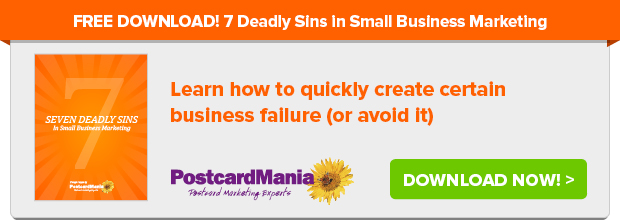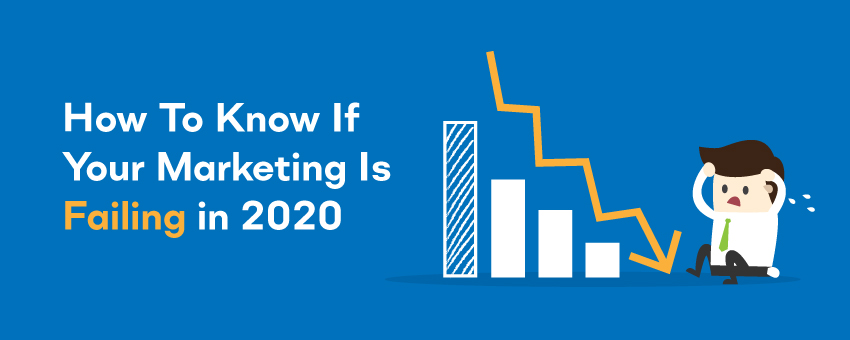How to Know if Your Marketing is Failing
Updated on November 5, 2021Because of the adverse financial effects most of us have experienced the past seven and a half months, more now than ever before:
We need our marketing to flat-out WORK.
None of us can afford any money out the door that doesn’t yield leads, new customers, and revenue.
And although that was true before 2021 started, I’m also laser-focused on making sure every marketing dollar counts…
Which got me thinking that this was a super important topic, one that I want to address directly and in-person…
First, I want to clarify one quick thing:
Marketing response and response rates are not the same thing.
Your response rate is a simple formula — divide the number of responses you receive by the number of people you contacted, then multiply by 100. I actually addressed response rates and why they aren’t a good indicator of marketing performance last week.
Marketing response is another story. It’s the overall effect created by your marketing, not just the number of people who respond in relation to your outflow.
So, how do you effectively measure your marketing response in 2021?
Back when I started PostcardMania in 1998, it was dead simple figuring out if your marketing was working:
Either the phone rang, or a customer came in the front door.
That was it.
But today, tracking your marketing response isn’t so straightforward thanks to the internet, and I REALLY need you to hear me out here:
Many customers of ours over the years have naturally called in to check up on their campaign and make sure it’s actually working. Sensible, right?
To make it easier for our customers, my software team developed an online campaign tracking dashboard to show customers exactly what’s going on with their campaign in real-time.
Why? Because we wanted you to call us less? Not at all.
I needed an effective way to SHOW customers that marketing response comes in many different forms, NOT just in a phone call or a customer physically walking in the front door.
Instead, consumers do their due diligence and research your business before you even know that they’re interested in you. They’re looking at:
- Your website
- Your online reviews
- Your social media profiles
- Your competitors
- Your competitor’s website
- And so on and so forth
Your business is put under a microscope before you even know that anyone is interested.
And once you’re under that microscope, your hard-earned leads could be disappearing.
And that is a big, fat WASTE.
Even without knowing you or your business as I write this, I can almost guarantee that leads are slipping through your virtual fingertips.
This subject is soooo important to me, I really need you to hear me out before you potentially think, “Oh, I know this already.”
We’ve been designing campaigns for over 91,000 clients over two decades, and as soon as the internet broke and websites became commonplace, I saw that the lead-disappearing act was thanks to the worst kind of magician:
A terrible website.
But a bad website isn’t just one that looks bad. It goes far deeper than that.
Literally:
Your website will either make or BREAK your marketing response in 2021.
I know it takes a LOT to spend money and market your business — now more than EVER thanks to the effects of the shutdowns this year.
So you cannot afford anymore odds stacked against you.
Your website represents your business, and if it’s missing critical design and functional components (which I’ll give you below), you risk losing the majority of your leads.
Just check out these stats:
- 95% of people will visit your website to check you out before they take any action with your business
- 96% of people who visit your website won’t contact you, because:
- 96% of website visitors are simply not ready to buy yet (or use this link: https://www.ventureharbour.com/20-insightful-lead-nurturing-statistics-charts/)
- 75% of people judge the credibility of a business based on its website
In other words:
Your leads are going to your website, that’s for sure.
So what do you do?? Shell out thousands of dollars to build a whole new website on the heels of a pandemic?
Thankfully, that’s not what I’m recommending…
But there are some key website must-haves you can easily give your web guy now (including this handy download).
1. Install the #1 website tracking tool on your website for FREE
Google Analytics is Google’s FREE tracking software that shows you a wealth of information, such as:
- Who’s visiting your website
- Where they’re coming from (Facebook, Google, etc.)
- Which pages they land on
- Which pages people bounce off of
- And WAY more.
You must have Google Analytics on your website in 2021, no holds barred, because it will inform you of so much information about your marketing response you’d never otherwise have.
FREE download: How to install Google Analytics step-by-step
2. Establish a purpose for your homepage (not only a nice design)
Do you want people to call? To buy something? To give you their email address so you can follow up later? (I suggest the latter one — ask for less upfront like an email address in order to generate more leads overall, and then follow up until those leads close.)
In order for your website to even begin generating leads for you, you need to define the #1 action step you want leads to ideally take.
That means you need to have a Call To Action (or CTA) — a statement that commands prospects to do something, such as:
Call now for a FREE quote.
Or:
Enter your email address to claim your discount.
Never assume that prospects will know what to do when they arrive at your website. They are busy people, and won’t take the time to figure much out, which is why this next point is vital…
3. Increase leads by 35% with a call-to-action that STANDS OUT
Don’t make your visitors scroll around before they see your call-to-action —
Present your call to action front and center so it’s impossible to miss.
A study on call-to-action conversion rates found that by simply changing the color emphasis on your call to action (from a color that matches your site to a totally different color entirely), you can increase the number of people who take action by over 35%.
That’s a huge difference for such a small change!
And it doesn’t have to match the rest of the site or your logo or anything – the bigger the contrast the better!
4. Make sure your website loads QUICKLY
Web users expect fast loading times. If your website takes too long to load… I’m talking just seconds here… you’ll lose visitors, leads and revenue.
Cut out anything that slows your homepage down. You want your homepage’s load time around the two-second mark — ideally, less!
Here’s some interesting proof:
Retail giant Walmart ran a test on their website’s load time and found that for every one second faster their website loaded, the conversion rate of non-buyers to buyers increased 2%.
Takeaway?
Speed matters!
5. Adjust your website for mobile to reach 60% more leads
If your website is responsive, that means it’s mobile-friendly and will automatically adjust to fit the screen of the device your visitors are using (Apple or Android smartphones, iPads, etc.).
Here’s why you should care about website responsiveness:
Over 60% of ALL online traffic now comes from mobile devices.
In addition:
Google recently updated their mobile search to favor websites that are mobile-friendly/responsive.
So what does that mean for you?
If your website isn’t responsive, Google will drop your site in its search results for mobile users — more than half the people online!
If you want to see if your website is responsive, Google has a Mobile-Friendly Test that will tell you. Try it out!
6. Use lead capture forms to grab leads who’d otherwise disappear
This is a biggie. If you want to turn your website visitors into leads, you have to collect their contact information so you can follow up.
But people are reluctant to give away their information, especially on the internet.
Make it worth their while by offering them something of value (for FREE) in return — it could be:
- Free samples
- A free quote
- A % off their first purchase
- A newsletter subscription
Need ideas for stealworthy special offers?
FREE download: 128 special offers PROVEN to generate leads
But, word to the wise:
Don’t ask for too much personal information from your online leads, and here’s why:
According to HubSpot, a lead capture form with only 3 fields (meaning you only ask for three bits of their information) will get 10% more conversions than a form with 6 fields.
You really only need their name and email address to follow up.
We ask for email only and then politely ask for more once we get that.
There are more design elements to address on your website, but the above 1-6 are the big ones.
You can download the full checklist we use with our website clients here.
We regularly consult clients on their websites because we know that today, it’s not a luxury to have a nice website — it’s a necessity.
If you need any help with your website or marketing your business during/after COVID-19, we offer one-on-one consultations for FREE with trained marketing experts. Just call 800-628-1804, and again:
It’s FREE.
As always, we are open and ready to help you!
Best,
Joy

2 Comments
Hi Karl! We encourage our clients to measure campaign success in terms of return on investment. A company that sells big-ticket items or services, such as a real estate agent, could see a tremendous ROI from just a single response, whereas a company that sells much less expensive everyday items such as clothing or jewelry will need many more responses and returning customers to see the same ROI. Any positive ROI is a success in my book! And direct mail can work for pretty much any business – even HUGE companies like Google mail postcards! It all comes down to using a targeted mailing list combined with effective postcard design. If you need help, we offer free marketing consultations when you call us at 800-628-1804! We can tell you what kinds of designs and mailing lists are working right now in YOUR industry!






Do you have a metric that for every marketing dollar spent, it should return X amount leads, sales, etc. This would vary based upon the product cost – $50 product compared to a $1000 product.
The other impression I have is your successful business model is using direct mail for much smaller businesses – dentist, hardware store, cleaning companies, etc.
Karl,